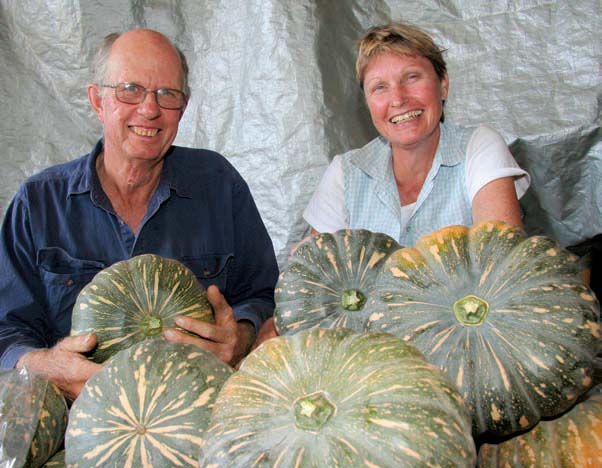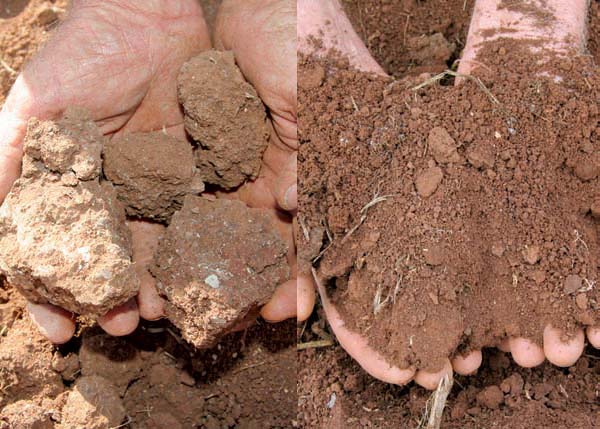
Case
Study
Location
Coleambally, New South Wales
Crop
Organic produce
Wiseman’s Organic Produce, Coleambally NSW
Former rice growers, Neill and Gina Wiseman, have transformed a block of worn-out station country into a thriving large-scale organic vegetable farm by using biological farming techniques.
Neill and Gina and their sons, Ryan and Luke, are now earning premiums from the sale of organic onions, pumpkins, soybeans and linseed grown on their 400, hectare property at Coleambally in the Riverina. They have also grown small areas of spelt wheat, rockmelon and watermelon and this year are planting trial crops of broccoli, lentils and chickpeas.
The current state of affairs is a dramatic about face for the Wisemans, who ran a technically sound conventional rice and grain enterprise for many years, a fact underscored by their win in a regional irrigated farm competition in 1996.

Neill and Gina Wiseman with Kent Special organic pumpkins grown on their irrigated farm at Coleambally, NSW.
They had developed and implemented a whole-farm plan, laser-graded their fields, installed a water recycling system, stopped burning crop stubble and switched from rice to more water-efficient crops such as soybeans, maize, wheat and barley.
“But to pay for it, we were really pushing the system,” Neill said. “Because it was easy to irrigate, we were growing two crops a year. We would just harvest one and stick the next one straight in.
“The wheels began to fall off because we had to use such high rates of fertiliser, needed to keep that regime going in our fragile soils.”
“The wheels began to fall off because we had to use such high rates of fertiliser, needed to keep that regime going in our fragile soils. Our last conventional corn crop had such bad rhizoctonia that its root system was almost non-existent.
“Most of it blew over in a windstorm, and we couldn’t harvest the rest because the header pulled the plants out of the ground. Ironically, we were told we needed to put more fertiliser on even though it wasn’t as economic as it was. Things were so bad we were about to sell up.”
It was then that they met biological farming experts, Jep Gates (co-founder of BioAg) and Ivan Mitchell, who convinced them that the massive doses of fertiliser and crop protection products being applied in the name of ‘good management’ were killing the soil biology.
“We had talked to a lot of people, but these two guys made sense,” Neill said. In 1998 the Wisemans started applying BioAgPhos®, lime and sulphate of ammonia with a belt spreader and converted two fields to organic agriculture.

Before and after: hard clumps of soil in a conventionally-farmed paddock compared to the soft, friable soil from a paddock converted to organic farming in 1998.
BioAgPhos is a reactive phosphate rock that has been treated with a proprietary microbial culture. About one third, of its 15% phosphorus content is available immediately for plant use, while the remainder is slowly digested by the micro-organisms and added to the nutrient reservoir in the soil. The improved soil microbial activity also unlocks phosphate, calcium and sulphur already in the soil, leading to long-term soil structure and fertility benefits.
“We grew three green manure crops in a row in one of the fields and the change in the soil was so dramatic that we went totally organic within the next 18 months,” Neill said.
“Since then our clay soil has changed from being like concrete to lovely, friable garden soil that’s full of earthworms. We get much better water efficiency and can go longer between watering.
“Our labour costs are higher because we do a lot of hand-weeding, but we buy heaps less fertiliser than we used to because we’re producing crops that don’t have to be rescued.
“Our plants are much healthier, so they don’t attract insect pests. Last year we had insect damage only on stressed plants that didn’t get enough water. This year we grew 130ha of soybeans with no insect damage at all.
“Because we don’t use insecticides, we have plenty of beneficial predatory insects like ladybirds and little wasps that knock out heliothis grubs.” Neill conceded that weeds were still a problem, particularly along irrigation channels. Regardless, they opt to use non-chemical control strategies, including mechanical methods and hand-weeding and grazing.
The Wisemans now implement an annual ‘fertility program’ incorporating a range of BioAg products, all of which are accredited organic inputs, in conjunction with conventional inputs.
“…their farm is living proof that large-scale biological or organic farms can be commercially successful.”
About 150-200kg per ha of BioAgPhos and 250-500kg per ha of lime are applied using a belt-spreader each year. The program also includes the use of a number of fermented liquid cultures, which deliver essential nutrients and metabolites directly to the crop, as well as stimulating microbial activity in the soil.
These include the liquid soil biology nutrient and seed inoculant, BioAg Soil & Seed™, which is added to irrigation water at the rate of 2-3L per ha before planting and at 1L per ha as needed during the growing season. Likewise, the foliar treatments, BioAg Balance & Grow® and BioAg Fruit & Balance™ are applied at 2L/ha using a boom spray at various stages during the growing season.
The Wisemans grow a green manure crop of faba beans, vetch, lupins, lab lab or cow peas before each vegetable crop. “Green manuring is expensive but you need to do it if you want to get top yields in the following cash crop,” Neill said.
Their soybeans are sold to processors, such as Vitasoy, while their onions and other vegies go to wholesale markets across Australia. Some onions finish up in organic hamburger patties for export to the U.S.
Neill and Gina believe their farm is living proof that large-scale biological or organic farms can be commercially successful. Indeed, in stark contrast to many of the family farms around them, their operation supports six full-time employees and a small army of casuals.
“We aim to market top quality produce under the organic banner and I believe we can do that under the BioAg program because we’re addressing nutrition in a scientific manner,” Neill said.
“Our ultimate goal is to grow enough product to sell on the conventional market and have people buy it because it looks better and tastes better, not just because it’s organic.
“We’ve had lots of comments on the flavour of our pumpkins and onions, and the first lot of organic onions we sent to market were queried because they looked exactly like conventional onions.”
Download case study
Download a PDF version of the above case study.

Recent Comments